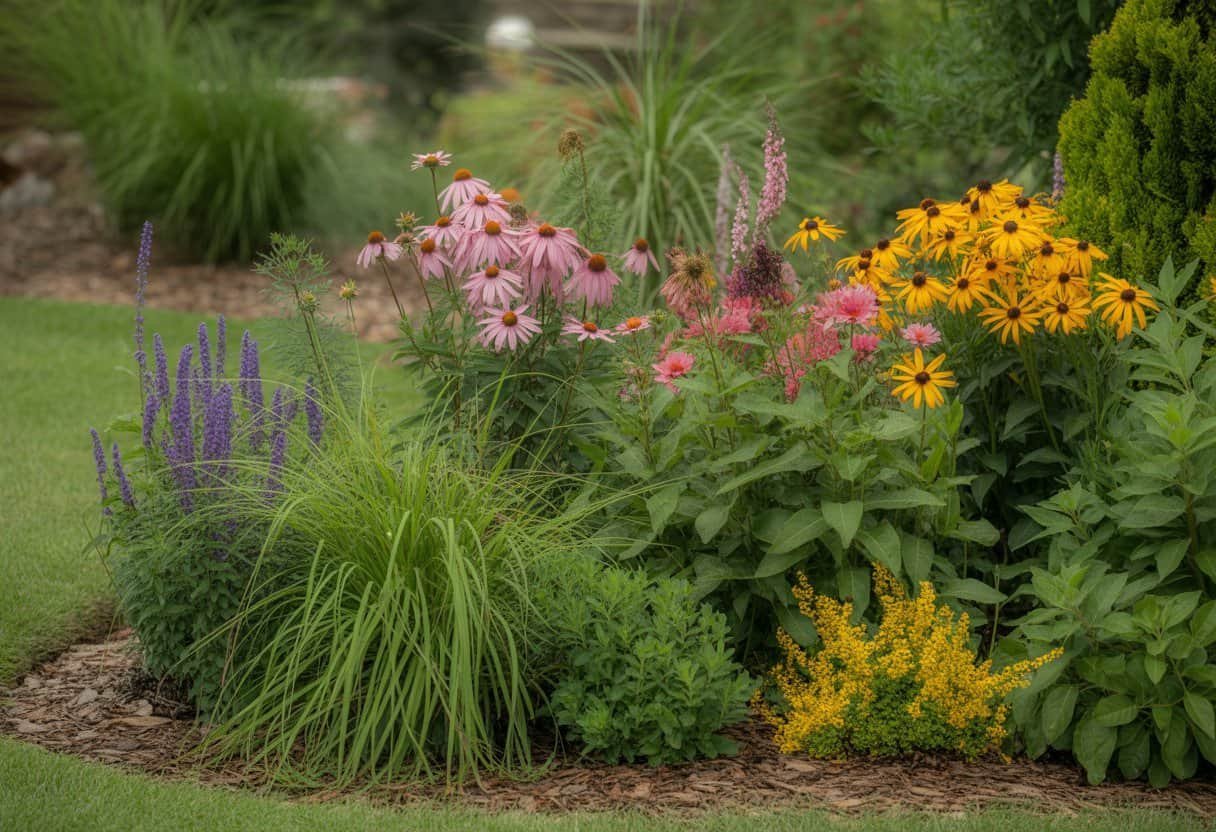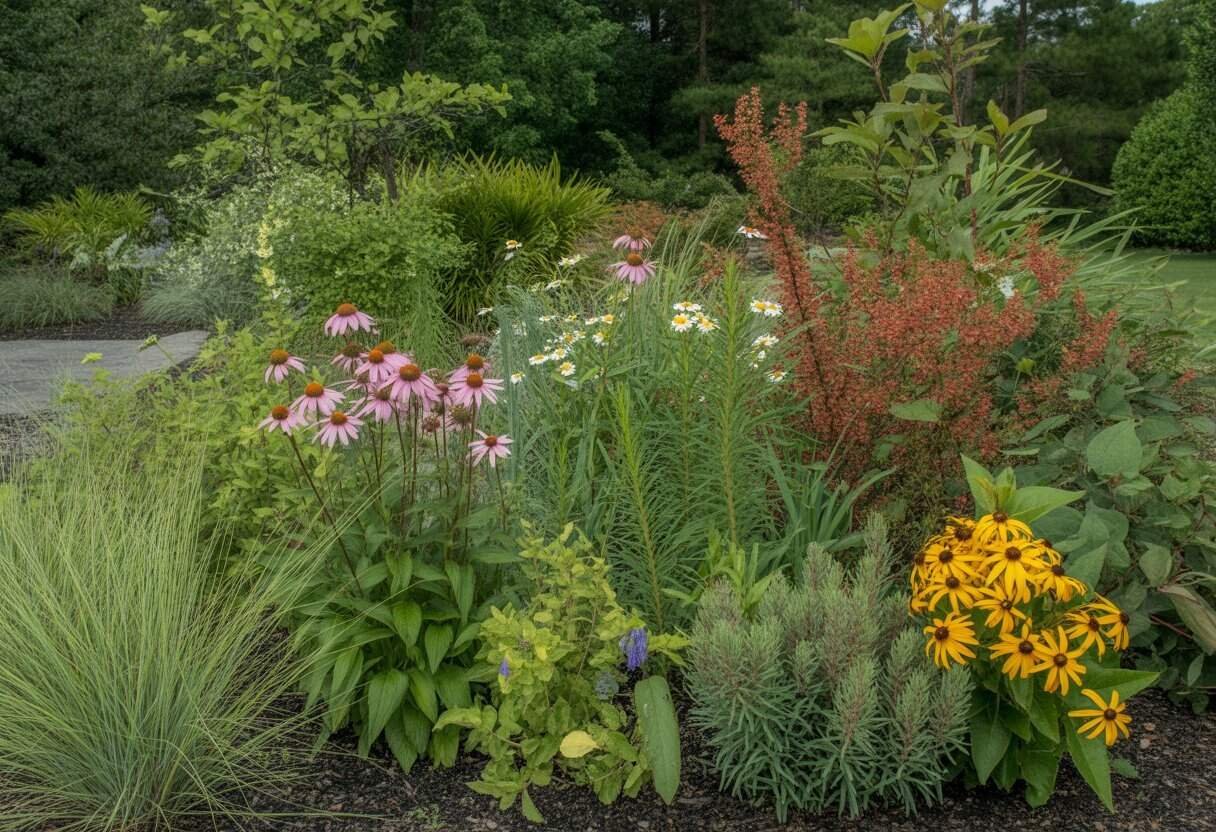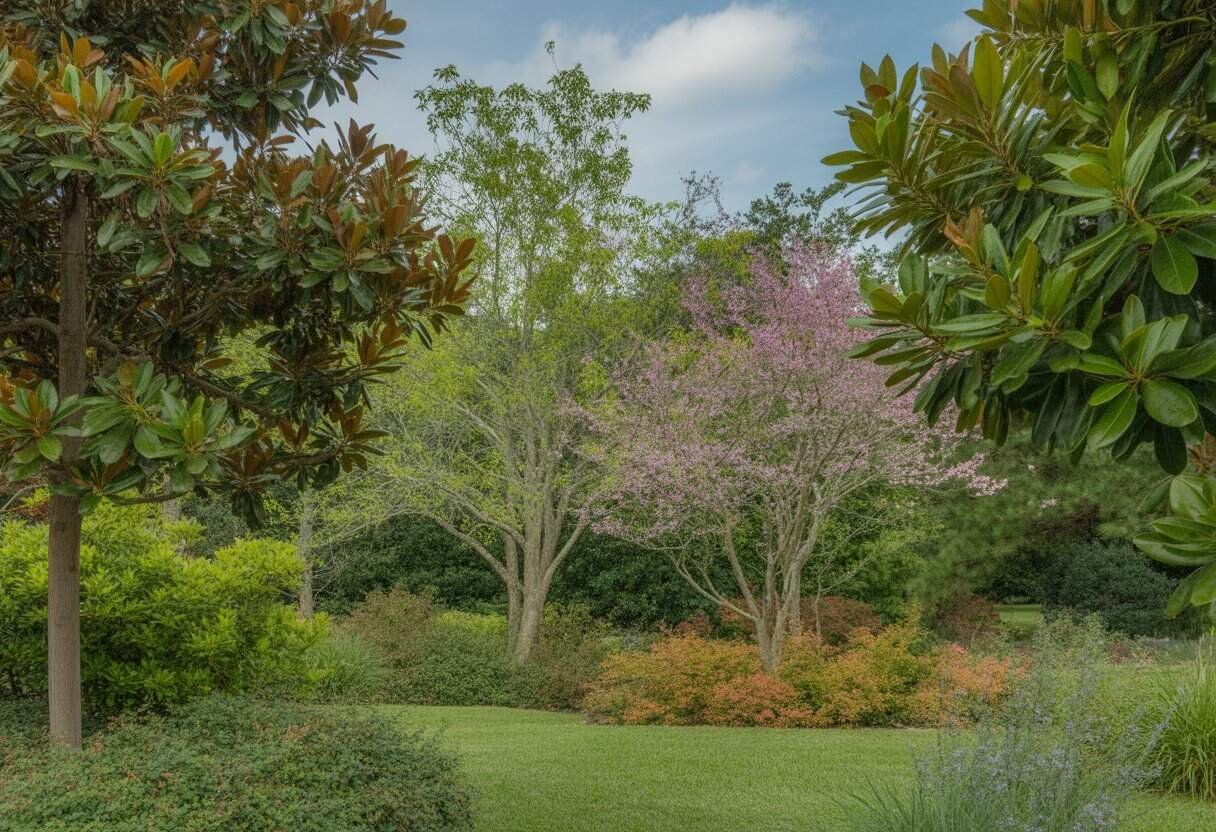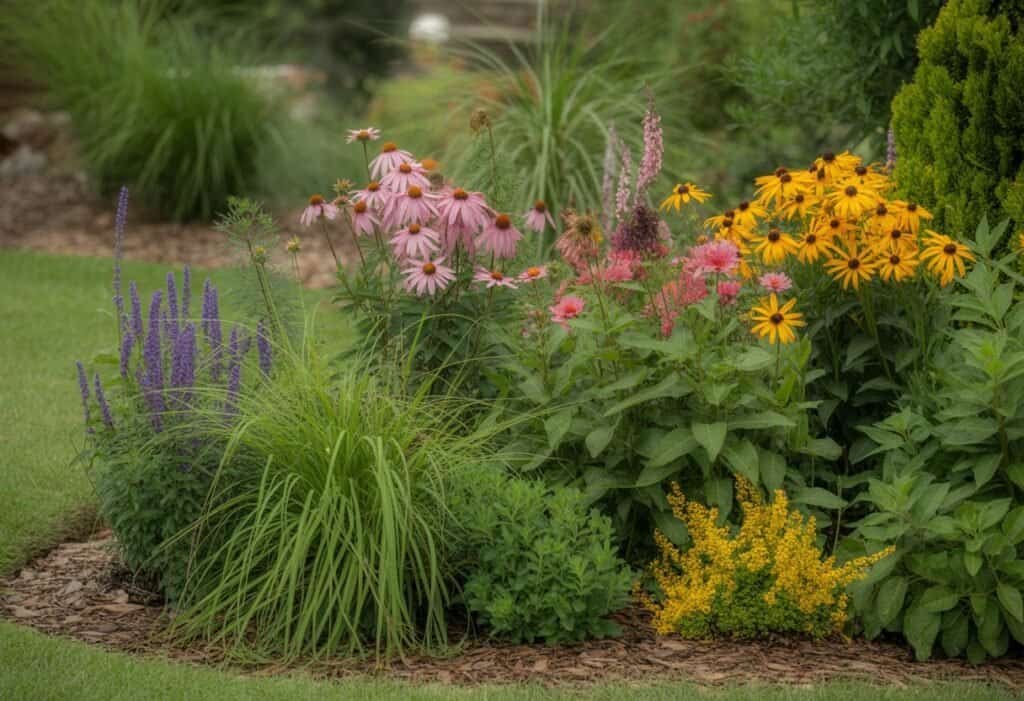Alabama’s native plants offer a beautiful way to enhance your yard while supporting local wildlife. These plants have adapted to the state’s climate and soil conditions over thousands of years, making them easier to maintain than non-native options.
Using native Alabama plants in your landscape saves water, reduces the need for fertilizers, and creates natural habitats for birds, butterflies, and beneficial insects.

From majestic oak trees to delicate wildflowers, Alabama’s native plant palette provides options for every garden style and need. You can create stunning landscapes that showcase the natural beauty of the Heart of Dixie.
Native plants tend to resist local pests and diseases. This resistance saves you time and money on maintenance.
Key Takeaways
- Native Alabama plants require less water, fertilizer, and maintenance while supporting local wildlife ecosystems.
- Alabama’s diverse native plant options include trees like Southern Magnolia, shrubs like Alabama Azalea, and wildflowers like Black-eyed Susan.
- Creating a landscape with native plants helps preserve Alabama’s natural heritage while providing sustainable beauty throughout the seasons.
Why Use Native Alabama Plants for Landscaping
Native Alabama plants offer practical solutions for homeowners who want beautiful, sustainable landscapes. These plants have adapted to local conditions over thousands of years.
They suit Alabama’s unique climate and soil types.
Benefits for Biodiversity and Local Ecosystems
Native plants form the foundation of Alabama’s natural ecosystems. When you plant them at home, they help maintain the ecological balance that supports local biodiversity.
These plants have co-evolved with local insects, birds, and other wildlife. They create important relationships that non-native species cannot replicate.
Landscapes with native plants support 3-5 times more bird and insect species than those dominated by non-native plants. This biodiversity helps control pest populations naturally.
Native plant communities also improve soil health by supporting beneficial fungi and microorganisms. These soil relationships help cycle nutrients efficiently and create healthier growing conditions for the entire landscape.
Water Conservation and Soil Erosion Control
Alabama native plants need much less water than non-native alternatives. Once established, many native species thrive on rainfall alone.
This water conservation is especially valuable during summer droughts. Native plant root systems are often deeper and more extensive than those of non-native plants.
These strong roots help:
- Stabilize slopes
- Prevent soil erosion
- Reduce stormwater runoff
- Filter pollutants before they reach waterways
Plants like switchgrass and river oats develop deep root systems that can reach 5-15 feet below the surface. This underground network holds soil in place even during heavy rain.
Enhancing Wildlife Habitat and Supporting Pollinators
Native plants provide essential food, shelter, and nesting sites for Alabama wildlife. Birds, mammals, and beneficial insects rely on these plants throughout their life cycles.
Key Alabama native plants for wildlife support:
- Oak trees: Support over 500 species of caterpillars
- Goldenrod: Provides late-season nectar for migrating butterflies
- Milkweed: Essential host plant for monarch butterflies
- Serviceberry: Produces berries that attract 35+ bird species
Native pollinators, including bees, butterflies, and hummingbirds, have specific relationships with native plants. These pollinators are essential for vegetable gardens, fruit trees, and the reproduction of about 80% of flowering plants in Alabama.
The decline in pollinator populations makes planting native species even more important. A landscape with diverse native plants helps create corridors that connect fragmented natural areas.
Key Considerations When Choosing Native Alabama Plants

Selecting the right native plants for your Alabama landscape requires understanding several important factors. These considerations help your plants thrive and provide ecological benefits.
Climate and USDA Hardiness Zones in Alabama
Alabama spans USDA hardiness zones 7a to 9a, with temperatures varying from north to south. The northern parts of the state (zones 7a-7b) experience colder winters with minimum temperatures of 0°F to 10°F.
Central Alabama falls into zone 8, while the Gulf Coast region sits in zone 9a. When selecting native plants, always check their hardiness zone compatibility.
Plants native to South Alabama may struggle in North Alabama’s colder climate. Alabama also experiences hot, humid summers and mild winters.
Annual rainfall averages 50-65 inches, with slightly higher amounts along the coast. This climate supports diverse plant communities but requires careful selection for specific microclimates within your landscape.
Alabama’s Hardiness Zones:
- North Alabama: Zones 7a-7b
- Central Alabama: Zone 8a-8b
- South Alabama: Zone 9a
Sunlight and Moisture Requirements
Native plants have specific light and water needs based on their natural habitats. Alabama’s diverse ecosystems include sunny meadows, woodland edges, and shady forests.
Light conditions to consider:
- Full sun: 6+ hours of direct sunlight
- Partial sun/shade: 3-6 hours of sun
- Full shade: Less than 3 hours of direct sun
Plants like Black-eyed Susans and Purple Coneflowers thrive in full sun. Alabama Azaleas and Woodland Phlox prefer partial shade.
Moisture requirements vary significantly. Some plants, like Swamp Sunflower and Cardinal Flower, need consistently moist soil.
Others, such as Yucca and Eastern Prickly Pear, prefer dry conditions. Group plants with similar moisture needs together in your landscape.
This practice, called hydrozoning, makes maintenance easier and ensures plants receive appropriate care.
Soil Preferences and Soil Conditions
Alabama’s soils vary widely across the state. The northern region features limestone-based soils, the central Black Belt has rich, dark clay, and the southern Coastal Plain has sandy, acidic soils.
Most native plants adapt to local soil conditions, but understanding your soil helps with selection. Test your soil to determine:
- pH level (acidity/alkalinity)
- Drainage characteristics
- Organic matter content
Many Alabama natives prefer slightly acidic soils (pH 5.5-6.5). Plants like Southern Magnolia and Azaleas thrive in acidic conditions.
Others like Eastern Redbud can tolerate more alkaline soils. Poor drainage can cause root rot in many species.
If you have clay soil, consider plants like Joe-Pye Weed that tolerate wet conditions. You can also improve drainage by adding organic matter.
Avoiding Invasive and Non-Native Species
When you select plants, avoid invasive species that can harm Alabama’s ecosystems. Some plants marketed as “native” may actually be aggressive non-natives or cultivars with fewer ecological benefits.
Tips for avoiding invasive species:
- Research plants before purchasing
- Use reliable native plant guides specific to Alabama
- Buy from nurseries specializing in native plants
Common invasive plants to avoid include Chinese Privet, Japanese Honeysuckle, and Bradford Pear. These plants escape cultivation and outcompete native species, reducing biodiversity.
Instead, choose true natives like Virginia Sweetspire, Trumpet Honeysuckle, and Serviceberry. Native plants support local wildlife and typically require less maintenance once established.
Trees Native to Alabama for Landscaping

Alabama’s diverse climate supports many beautiful native trees. These trees thrive in local landscapes with minimal maintenance.
They provide shade, habitat for wildlife, and seasonal interest. Native trees usually require less water and care than non-native species.
Flowering Dogwood (Cornus florida)
Flowering dogwood is one of Alabama’s most beloved native trees. This small tree typically grows 15-30 feet tall with a distinctive horizontal branching pattern.
In spring, dogwoods produce showy white or pink bracts that create a stunning display. The true flowers are the small yellowish clusters in the center.
In fall, dogwoods develop bright red berries that attract birds and wildlife. Their foliage turns a beautiful reddish-purple, adding autumn interest to any landscape.
Dogwoods prefer partial shade and well-drained, slightly acidic soil. They work well as understory trees beneath taller oaks and pines.
Plant dogwoods where they’ll receive morning sun but afternoon shade for best results.
Southern Magnolia
Southern magnolia (Magnolia grandiflora) stands as an iconic symbol of Alabama. This majestic evergreen tree grows 60-80 feet tall with a spread of 30-50 feet.
The glossy, dark green leaves have rusty-brown undersides, creating a dramatic two-toned effect. Southern magnolias produce large, fragrant white flowers from May through June.
Their seed cones reveal bright red seeds in fall, attracting birds and adding visual interest. These trees make excellent specimen plants or privacy screens.
Southern magnolias prefer full sun to light shade and adapt to various soil types. They’re drought-tolerant once established but appreciate regular watering during dry spells.
Consider their large size when planting near structures or power lines.
Red Maple (Acer rubrum)
Red maple brings multi-season interest to Alabama landscapes. This fast-growing deciduous tree reaches 40-60 feet tall with a rounded crown.
In late winter, red maples burst with tiny red flowers before leaves emerge. New leaves appear with a reddish tint before turning green.
In fall, leaves transform into brilliant shades of red and orange. Red maples adapt to various soil conditions, from dry uplands to wet areas.
These versatile trees work well as shade trees, street trees, or focal points. They attract wildlife and provide important early-season nectar for pollinators.
Red maples grow best in full sun to partial shade and moderate moisture.
Boxelder Maple (Acer negundo) and Other Native Trees
Boxelder maple is a fast-growing native tree reaching 30-50 feet tall. This adaptable species tolerates poor soils, drought, and flooding.
Male and female flowers grow on separate trees. Female trees produce distinctive winged seed clusters.
While not as showy as other maples, boxelders provide excellent wildlife habitat and erosion control.
Other valuable native Alabama trees include:
- Sweetbay Magnolia: Smaller than southern magnolia with fragrant cream flowers
- Eastern Redbud: Early spring purple-pink flowers on a small tree
- Blackgum: Outstanding fall color and berries for wildlife
- River Birch: Attractive peeling bark and adaptability to wet sites
When selecting native trees, consider your specific site conditions. Choose trees that match your soil type, sun exposure, and available space.
Native Shrubs to Enhance Your Alabama Landscape
Alabama’s native shrubs offer beauty, wildlife benefits, and adaptability to local growing conditions. These plants thrive with minimal maintenance while supporting local ecosystems.
Oakleaf Hydrangea (Hydrangea quercifolia)
Oakleaf hydrangea is an Alabama treasure and the state’s official wildflower. This stunning shrub grows 4-8 feet tall with distinctive lobed leaves resembling oak trees.
In summer, it produces dramatic white flower clusters that gradually turn pink and then rusty brown as seasons change. These blooms last for months, providing long-lasting beauty.
The fall display is equally impressive with leaves turning brilliant shades of red, orange, and purple. During winter, the exfoliating bark adds visual interest to the landscape.
Oakleaf hydrangeas prefer partial shade and adapt well to various soil conditions. They thrive in woodland edges and work beautifully as foundation plantings or in mixed borders.
American Beautyberry (Callicarpa americana)
American beautyberry captivates gardeners with its spectacular purple berries that form tight clusters around the stems in fall. This native shrub grows 3-5 feet tall with an arching habit.
The berries persist into winter, providing food for birds and adding vibrant color to the landscape when other plants go dormant. While the purple variety is most common, white-berried forms also exist.
Beautyberry grows best in part shade but tolerates full sun with adequate moisture. It adapts to different soil types and requires little maintenance.
Wildlife enthusiasts appreciate this shrub for its berries and because its foliage serves as food for various butterfly caterpillars.
Red Buckeye (Aesculus pavia)
Red buckeye delivers striking crimson tubular flowers in early spring that attract hummingbirds and butterflies. This compact shrub typically reaches 10-15 feet tall but can remain smaller in gardens.
The palmate leaves emerge early in spring, providing a lush backdrop for the showy red flower clusters. After flowering, the plant produces glossy brown nuts that resemble chestnuts.
Red buckeye prefers partial shade and moist, well-drained soil. It’s valuable for woodland gardens and naturalized areas.
This native shrub is deer-resistant, making it practical for areas with high deer pressure.
Coral Honeysuckle (Lonicera sempervirens)
Coral honeysuckle is a versatile semi-woody vine that gardeners can train as a shrub. Its tubular coral-red flowers bloom from spring through fall, creating a spectacular display.
Unlike invasive Japanese honeysuckle, this native vine behaves well in gardens while providing essential nectar for hummingbirds, butterflies, and bees. The red berries that follow the flowers attract songbirds.
This plant thrives in full sun to part shade and adapts to various soil conditions once established. It becomes drought-tolerant after its first year.
Gardeners can use coral honeysuckle on trellises, fences, or as a groundcover. Its evergreen to semi-evergreen foliage provides year-round structure in Alabama landscapes.
Colorful Native Flowers and Perennials
Alabama’s landscape comes alive with native flowering plants that add vibrant colors while supporting local wildlife. These hardy perennials thrive in Alabama’s climate and require less maintenance than non-native alternatives.
Eastern Columbine
Eastern Columbine (Aquilegia canadensis) displays unique red and yellow nodding flowers with distinctive spurs. This eye-catching perennial blooms from March to May, reaching heights of 1-3 feet.
Eastern Columbine grows best in partial shade and well-drained soil. It adapts to different conditions, including rocky or clay soils.
Wildlife benefits:
- Attracts hummingbirds and butterflies
- Provides early-season nectar
- Supports native pollinators
This plant self-seeds readily, creating natural colonies over time. Its delicate, compound leaves add texture to garden borders even when not in bloom.
Milkweed and Pollinator-Friendly Wildflowers
Milkweed species native to Alabama serve as essential host plants for monarch butterflies. Butterfly Milkweed (Asclepias tuberosa) produces bright orange flower clusters from May through September.
Common Milkweed (Asclepias syriaca) and Swamp Milkweed (Asclepias incarnata) also thrive in Alabama. These plants prefer full sun and tolerate drought once established.
Passionflower (Passiflora incarnata) produces intricate purple flowers followed by edible fruits. This native vine serves as a host plant for Gulf Fritillary butterflies.
Creating a pollinator garden with these natives helps support:
- Monarch butterflies
- Native bees
- Hummingbirds
- Various beneficial insects
Wavyleaf Purple Coneflower and Largeflower Tickseed
Wavyleaf Purple Coneflower (Echinacea simulata) stands 2-4 feet tall with distinctive purple ray flowers surrounding a cone-shaped center. This drought-tolerant perennial blooms from June through August, attracting many pollinators.
Largeflower Tickseed (Coreopsis grandiflora) brings golden-yellow blooms from May to July. Growing 1-2 feet tall, it thrives in full sun and adapts to poor soil conditions.
Both plants offer:
- Long blooming periods
- Drought tolerance
- Low maintenance requirements
- Wildlife value
These native perennials work well in meadow gardens, borders, and naturalized areas. Deadheading spent flowers encourages reblooming and prevents excessive self-seeding.
Green-and-Gold (Chrysogonum virginianum)
Green-and-Gold creates a stunning groundcover with bright yellow star-shaped flowers against emerald-green foliage. This low-growing perennial reaches only 6-10 inches tall but spreads gradually to form attractive colonies.
Blooming primarily in spring (March-May), Green-and-Gold often produces scattered flowers throughout summer in optimal conditions. It prefers partial shade and moist, well-drained soil.
Key benefits include:
- Erosion control on slopes
- Shade tolerance
- Deer resistance
- Early spring color
Green-and-Gold works well in woodland gardens, along pathways, or as a border edge. It combines well with other native shade lovers and requires minimal maintenance once established.
Native Grasses and Groundcovers for Alabama Gardens
Alabama’s native grasses and groundcovers offer beautiful, low-maintenance options for your landscape. These plants provide texture, color, and important habitat for local wildlife while requiring less water and care than non-native alternatives.
Climbing Aster and Ironweed
Climbing Aster (Symphyotrichum carolinianum) brings delicate purple blooms to Alabama gardens from late summer through fall. This versatile plant can sprawl as a groundcover or climb up to 6 feet when given support.
It thrives in moist soils and partial shade. Ironweed (Vernonia) stands tall in the landscape with its deep purple flower clusters.
Several native species grow naturally in Alabama, reaching heights of 3-7 feet. These plants attract butterflies and provide late-season nectar.
Both plants are drought-tolerant once established. They work well in naturalized areas and wildflower gardens.
For best results, plant Climbing Aster in areas with morning sun and afternoon shade. Ironweed prefers full sun but can handle partial shade.
Pussytoes and American Bluehearts
Pussytoes (Antennaria plantaginifolia) forms a low, silvery-gray mat of foliage reaching just 3-6 inches tall. The plant gets its name from the fuzzy white flower clusters that resemble cat paws.
It spreads slowly to create an effective groundcover for dry, sunny spots. American Bluehearts (Buchnera americana) adds delicate blue-purple spikes to the garden from spring through summer.
Growing 1-2 feet tall, this native perennial thrives in average to poor soils. Both plants require minimal maintenance once established.
Pussytoes works well in rock gardens and between stepping stones. Its drought tolerance makes it perfect for areas that receive little water.
American Bluehearts pairs well with native grasses and attracts pollinators to the garden.
Low-Maintenance Ornamental Grasses
Little Bluestem (Schizachyrium scoparium) stands out among Alabama’s native grasses. Its blue-green summer foliage turns a striking copper-orange in fall, reaching 2-3 feet tall.
The fluffy seed heads catch light beautifully. Pink Muhly Grass (Muhlenbergia capillaris) creates a stunning pink cloud effect in fall when its airy seed heads emerge.
Growing 3-4 feet tall, this grass tolerates poor soils and drought. River Oats (Chasmanthium latifolium) offers unique flat seedheads that dangle from arching stems.
It grows well in shade or sun and reaches 2-5 feet tall.
Planting tips:
- Space grasses according to mature width
- Cut back in late winter before new growth appears
- Divide clumps every 3-4 years to maintain vigor
Designing Sustainable Alabama Landscapes with Native Plants
Native plants help Alabama homeowners create beautiful landscapes that need less maintenance and benefit the local environment. These plants have adapted to our region’s climate and soil conditions over thousands of years.
Creating a Wildlife-Friendly Home Landscape
Native plants attract local wildlife that evolved alongside them. Alabama gardens with native species like Eastern purple coneflower, cardinal flower, and black-eyed Susans become havens for pollinators.
Birds benefit from trees like red maples and Southern magnolias that provide nesting sites and food. Berry-producing shrubs such as American beautyberry and yaupon holly offer essential nutrition through winter months.
Water features with native aquatic plants create complete habitat systems. Even small ponds with arrowhead and pickerelweed support frogs, dragonflies, and other beneficial creatures.
Wildlife-Friendly Tips:
- Plant in clusters to make food sources more visible to pollinators
- Include plants that flower at different times of year
- Reduce lawn areas in favor of diverse native plantings
- Avoid pesticides that harm beneficial insects
Plant Communities and Companion Planting
Alabama’s natural plant communities offer perfect blueprints for home landscapes. Plants that grow together in nature often support each other’s health and growth requirements.
Woodland gardens might combine understory trees like dogwoods with shade-loving plants such as Christmas fern and wild ginger. These combinations mimic forest edges found throughout Alabama.
Prairie-inspired gardens pair grasses like little bluestem with flowering perennials including butterflyweed and blazing star. These plants thrive together in sunny locations.
Companion planting improves soil health naturally. Deep-rooted plants like prairie dropseed help break up clay soils, while nitrogen-fixing species such as partridge pea improve soil fertility for neighboring plants.
Erosion Prevention and Water-Wise Gardening
Alabama’s heavy rainfall can cause serious erosion problems on slopes and near waterways. Native plants with extensive root systems help hold soil in place.
For steep slopes, consider:
- Switchgrass (deep roots stabilize soil)
- River oats (spreads to form erosion-resistant mats)
- Alabama supplejack (controls erosion in woodland settings)
Water-wise gardens help manage stormwater while reducing maintenance needs. Rain gardens planted with water-tolerant species like blue flag iris and swamp milkweed capture runoff from roofs and driveways.
Mulching with pine straw or hardwood mulch helps retain soil moisture. This practice in Alabama landscapes reduces water needs while suppressing weeds and moderating soil temperatures.
Resources for Finding and Learning About Native Alabama Plants
Alabama offers many places to find native plants and learn about them. These resources help both new gardeners and experienced landscapers create beautiful, sustainable gardens with local species.
Birmingham Botanical Gardens and Local Nurseries
The Birmingham Botanical Gardens serves as an excellent resource for learning about Alabama’s native plants. Their Native Plant Garden showcases over 60 species that naturally occur in Alabama.
Visitors can see these plants in natural settings and learn proper growing techniques. Many local nurseries now specialize in native plants.
Some noteworthy options include:
- Petals from the Past in Jemison
- The Plantory in Birmingham
- Walker County Natives in Jasper
These nurseries often provide detailed care information and can recommend species suited to specific yard conditions. Most offer seasonal workshops on native plant gardening techniques and maintenance.
The Alabama Cooperative Extension System also provides free publications about native landscaping. Their online database includes planting guides specific to different Alabama regions.
Supporting Endangered Species and Local Wildlife
Alabama ranks fifth in the nation for biodiversity but also has many endangered plant species. Organizations like the Alabama Plant Conservation Alliance work to protect these vulnerable plants through preservation efforts.
When selecting native plants, look for those that support local wildlife. Species like:
- Eastern purple coneflower (attracts butterflies)
- Cardinal flower (feeds hummingbirds)
- Oakleaf hydrangea (provides shelter for birds)
The Alabama Wildlife Federation offers certification for yards that support local ecosystems. Their website provides guidance on creating wildlife habitats using native plants.
The Nature Conservancy of Alabama maintains several preserves where visitors can observe native plants in their natural habitats. These locations offer educational programs throughout the year focused on conservation and native species identification.
Frequently Asked Questions
Alabama offers a rich variety of native plants that create beautiful, sustainable landscapes. These plants have adapted to local conditions and provide numerous benefits to homeowners and the environment.
What are some low maintenance native plants suitable for landscaping in Alabama?
Alabama’s low maintenance native plants include Yaupon Holly, which thrives with minimal care and offers year-round greenery. This versatile shrub tolerates drought and poor soils.
Eastern Red Cedar requires almost no maintenance once established. It provides excellent windbreaks and wildlife habitat without demanding regular attention.
Muhly Grass creates spectacular pink-purple plumes in fall while needing little water or fertilizer. Its drought tolerance makes it perfect for busy homeowners seeking beauty without extensive upkeep.
Which native Alabama plants are best for creating a vibrant landscape?
Black-eyed Susan delivers bright yellow blooms from summer through fall. These cheerful flowers attract butterflies and create stunning mass plantings with minimal effort.
Scarlet Sage produces vivid red spikes that hummingbirds find irresistible. The intense color creates focal points in gardens from late spring until frost.
Alabama Azalea offers spectacular spring displays with fragrant pink or white flowers. This deciduous native shrub provides structure and seasonal interest to woodland-style gardens.
What evergreen plants from Alabama are recommended for year-round landscaping?
American Holly stands as a magnificent evergreen tree with distinctive red berries in winter. Its dark green foliage provides structure and screening throughout all seasons.
Southern Magnolia features glossy leaves and fragrant white flowers. This iconic tree keeps its impressive appearance all year in larger landscapes.
Inkberry Holly offers a compact evergreen option for smaller spaces. Its neat growth makes it excellent for foundations and formal gardens.
Can you list native flowers that thrive in Alabama gardens?
Coneflowers bloom from summer through fall with minimal care. Their purple, pink, or white flowers attract beneficial insects and birds.
Alabama’s native Phlox species carpet areas with fragrant blooms in spring. These low-growing flowers work well in rock gardens and borders.
Cardinal Flower produces striking red spikes that brighten moist areas of the garden. This plant thrives in partial shade and attracts hummingbirds.
Which native plants are ideal for North Alabama landscaping projects?
Serviceberry trees bring four-season interest to North Alabama landscapes. Their spring flowers, summer berries, fall color, and winter bark create year-round appeal.
Aromatic Aster thrives in North Alabama with its lavender-blue flowers in fall. This tough plant handles the region’s clay soils well.
Oakleaf Hydrangea grows beautifully in North Alabama’s woodland settings. Its distinctive leaves, summer flowers, and fall color make it a versatile landscape choice.
What are the benefits of using native plants in Alabama landscapes?
Native plants significantly reduce water consumption once established. They adapt to local rainfall patterns, so you need less supplemental irrigation and pay lower water bills.
Wildlife thrives with native plantings. Birds, butterflies, and beneficial insects find food and shelter in these plants.
Native plants require less maintenance. Their natural resistance to local pests and diseases means you use fewer chemicals and spend less time on garden upkeep.


